Paving the Lakefront with Concrete
WisDOT deal with city will create a 10-lane roadway along the lake.
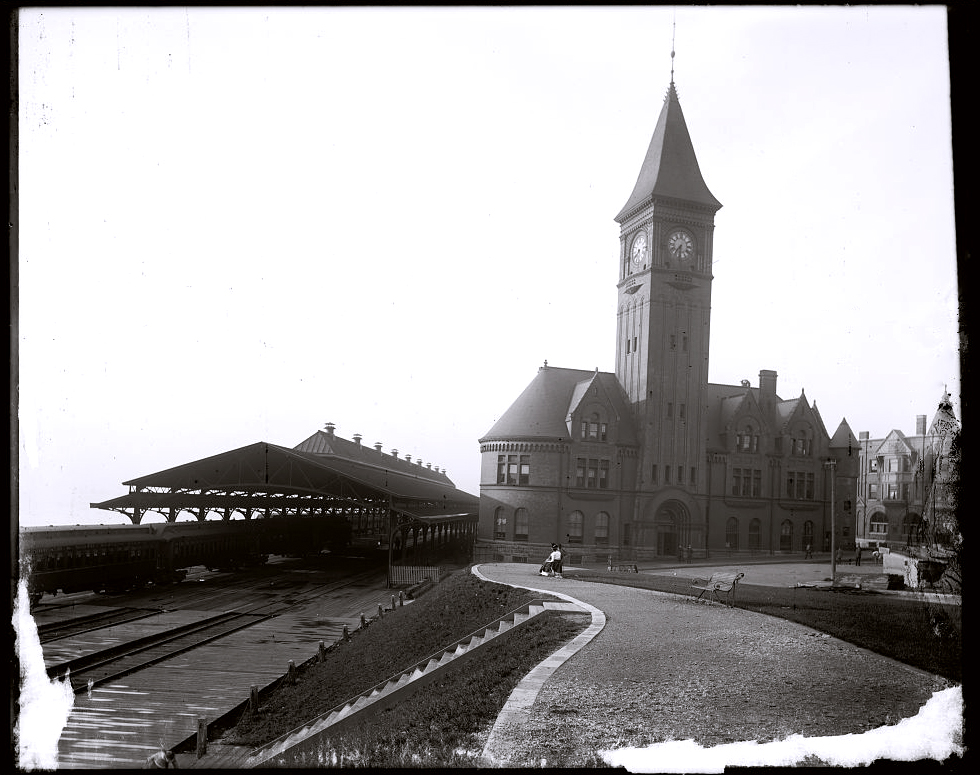 This used to be the gateway to Milwaukee. The Chicago & Northwestern lakefront depot was a status symbol when it was built in 1890. A picture post-card view demolished in 1968 to make room for a freeway.
The Park East freeway was never built so this plot of land sat for more than two decades until O’Donnell Park was built in 1990. “Park in a Park!” is the headline on its website, but it’s really a large garage with a corporate patio on top. It was government boondoggle that surprised everyone by blocking many views of the lake.
This used to be the gateway to Milwaukee. The Chicago & Northwestern lakefront depot was a status symbol when it was built in 1890. A picture post-card view demolished in 1968 to make room for a freeway.
The Park East freeway was never built so this plot of land sat for more than two decades until O’Donnell Park was built in 1990. “Park in a Park!” is the headline on its website, but it’s really a large garage with a corporate patio on top. It was government boondoggle that surprised everyone by blocking many views of the lake.
This course of events illustrates the old parable every architect and urban planner learns in college. It starts with Jane Jacobs’ fight against Robert Moses’s plan to run a freeway through Greenwich Village in Manhattan, if you can imagine that.
Jacob’s book, The Death and Life of Great American Cities (1961) was a revelation like the germ theory of disease. Finally, after decades of failure of urban renewal, we understood what was killing cities. The monoculture of the automobile, with its amalgamation of freeways, ramps, and parking lots. America’s 20th Century love affair with the automobile was consuming vast swatches of prime urban real estate, turning cities that used to be destinations into vacuous drive-thrus for people going someplace else.
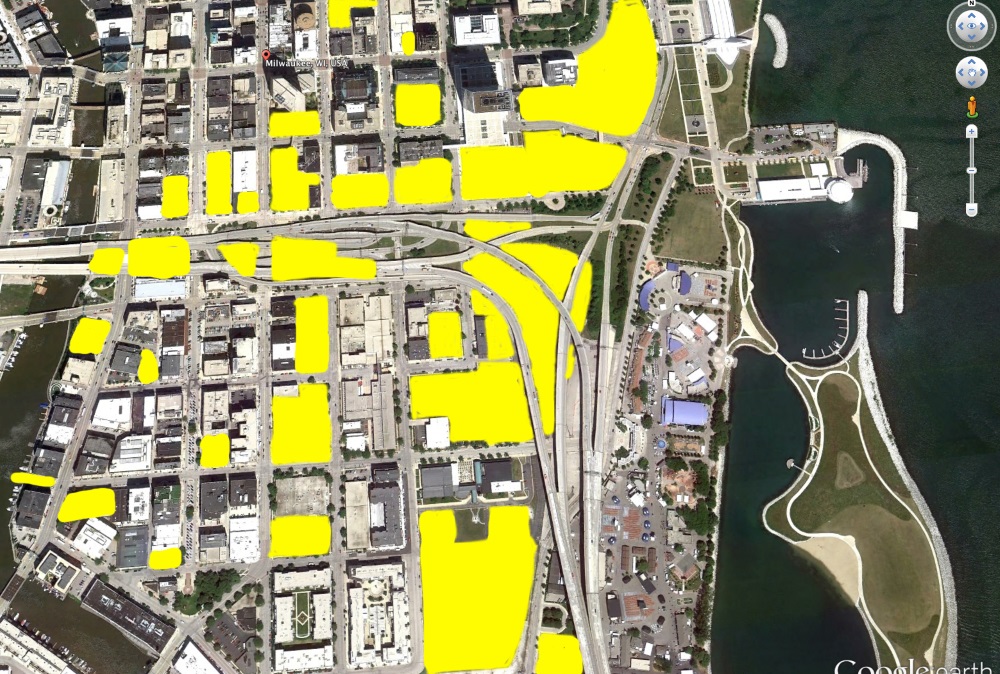 The areas marked in yellow are all parking lots. The center of this infestation is O’Donnell Park. Yet it is framed by the Northwestern Mutual complex, U.S. Bank Center, the University Club, Kilbourn Tower, Juneau Park, the Milwaukee Art Museum and Discovery World, not to mention Lake Michigan, McKinley Marina, Summerfest, Lake Shore State Park, and the Third Ward.
The areas marked in yellow are all parking lots. The center of this infestation is O’Donnell Park. Yet it is framed by the Northwestern Mutual complex, U.S. Bank Center, the University Club, Kilbourn Tower, Juneau Park, the Milwaukee Art Museum and Discovery World, not to mention Lake Michigan, McKinley Marina, Summerfest, Lake Shore State Park, and the Third Ward.
The disease is reversible only if you realize the transportation infrastructure that perpetuates suburban development drains the life out of cities. Think of it this way, if we got rid of all the parking, O’Donnell Park in Milwaukee could be like Central Park in New York.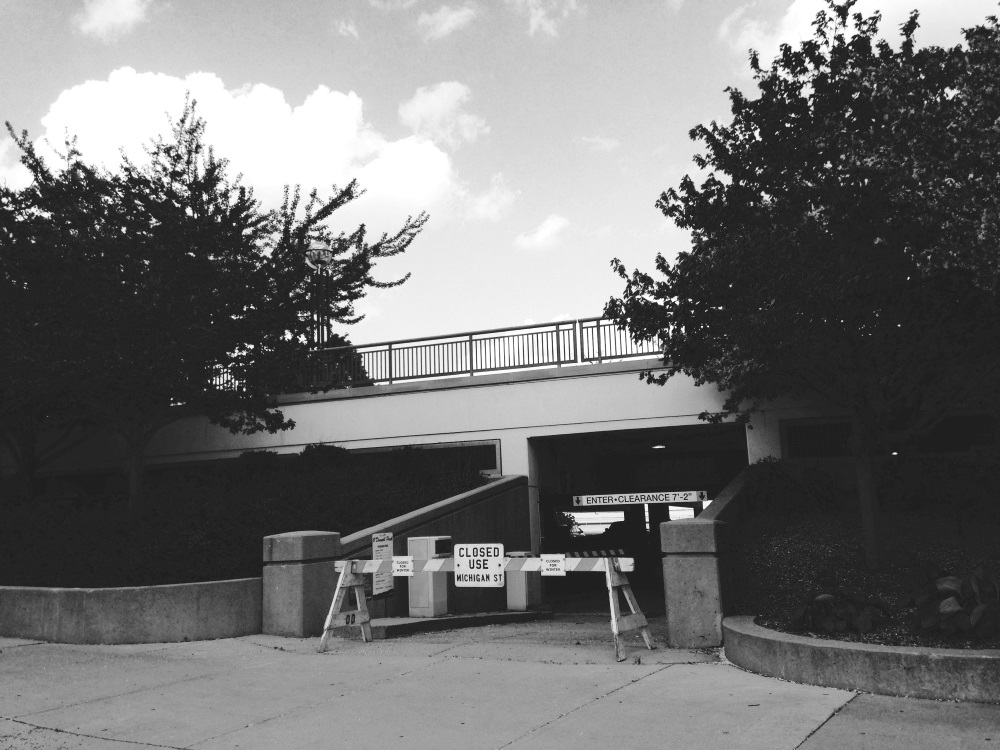 Now there is a new plan for this area — the heart of our Downtown — that has been either a vacant lot or parking garage for 46 years. At least that is the way the new Gateway project is being presented. (An overview of the project can be found here. The renderings are available here).
Now there is a new plan for this area — the heart of our Downtown — that has been either a vacant lot or parking garage for 46 years. At least that is the way the new Gateway project is being presented. (An overview of the project can be found here. The renderings are available here).
The pictures have a swanky futuristic feel. New high rises buildings reach for the sky and a foot bridge swirls down to a new plaza. The plan is garnished with some “green” modifications, including a urban and linear bio-filtration basin. A bicycle path is thrown in.
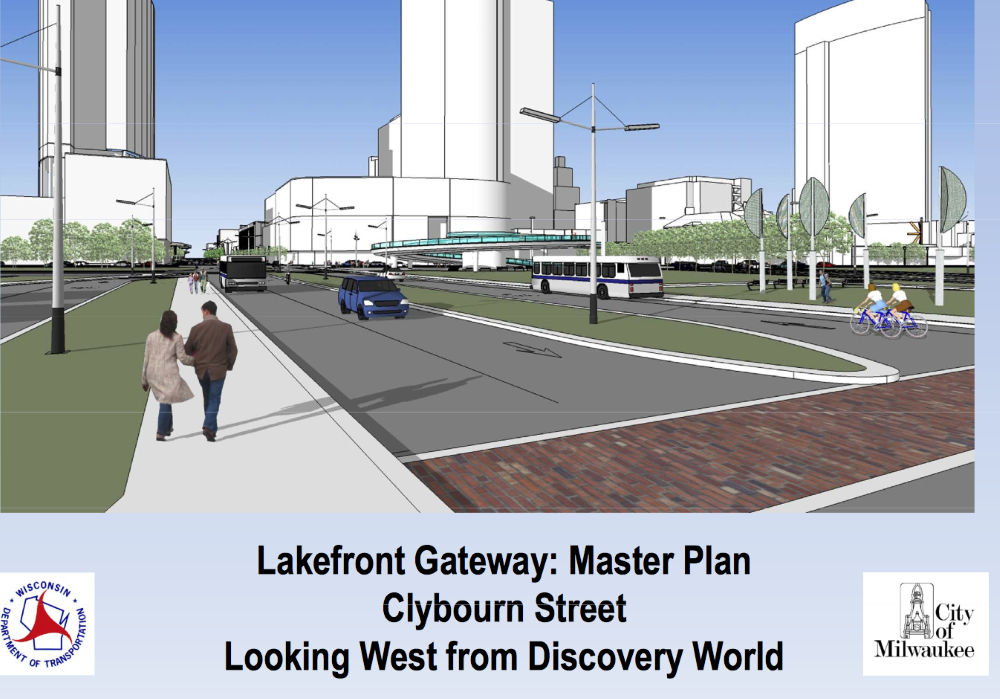 Still, this is basically a project by the Wisconsin Department of Transportation. Every 30 or so years the interstate highway system is rebuilt so Mayor Tom Barrett’s administration struck up a deal with the state to make some changes, provided that none of them changed the flow of traffic on the system. As WisDOT has entitled the project, it is The I-794 Lakefront Gateway Project Lincoln Memorial Drive ramps, Lincoln Memorial Drive, Local Street Milwaukee County.
Still, this is basically a project by the Wisconsin Department of Transportation. Every 30 or so years the interstate highway system is rebuilt so Mayor Tom Barrett’s administration struck up a deal with the state to make some changes, provided that none of them changed the flow of traffic on the system. As WisDOT has entitled the project, it is The I-794 Lakefront Gateway Project Lincoln Memorial Drive ramps, Lincoln Memorial Drive, Local Street Milwaukee County.
Under this deal, the exit and on ramps of I-794 will be moved a block south to Summerfest, which opens up a plot of land for development on the southwest corner of Clybourn and Lincoln Memorial Drive. This also gives the intersections by the museums on Lincoln Memorial Drive more room to breath.
Clybourn Street will become a boulevard a few blocks east of Lincoln Memorial Drive, providing a more dignified gateway to Discovery World. Lincoln Memorial Drive will be extended underneath the freeway to Chicago Street in the Third Ward.
The extension to Chicago Street is a big deal. I never understood why neither Prospect nor Lincoln Memorial Drive didn’t go through Downtown, leaving the 6th St. bridges to tie the north and south side of Milwaukee together.
On paper this seems like a small triumph for the city. Barrett was able to get some additional space for development that will increase the density and tax base, and provide a psychological buffer between Clybourn and the freeway that will enhance the view looking east to Discovery World. And who knows, spur some new development on the O’Donnell Park site? But these modification could have a serious unintended consequence. Squeezing the ramps of the Hoan Bridge and I-794 together with the extension to Chicago Street creates an enormously complex intersection that adds up to 10 lanes of concrete at Lincoln Memorial Drive and Clybourn.
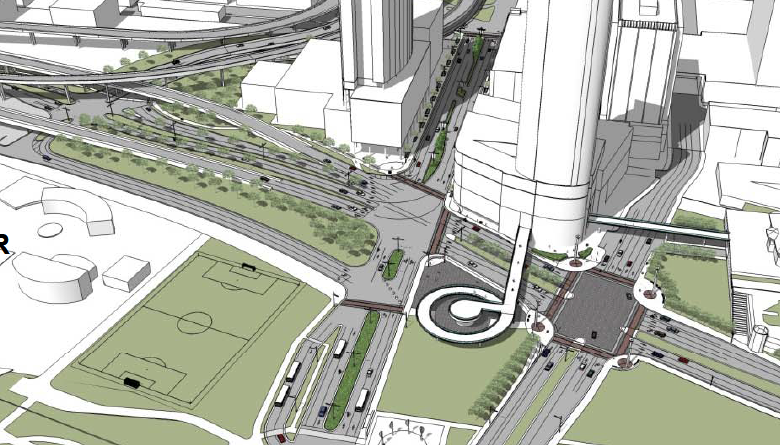
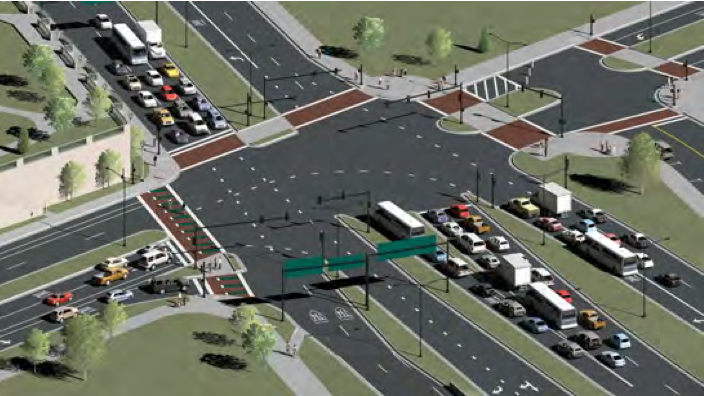 This will bring a lot of cars onto Lincoln Memorial Drive, making it more like a freeway than a city street. Two clunky intersections at Michigan and Clybourn are streamlined but the lakefront starts to feel like an airport.
This will bring a lot of cars onto Lincoln Memorial Drive, making it more like a freeway than a city street. Two clunky intersections at Michigan and Clybourn are streamlined but the lakefront starts to feel like an airport.
As WisDOT spokespersons Carolynn Gellings and Michael Pyritz explain it — the plan had to maintain the status quo. They are in the circulation business. More specifically, WisDOT’s job is to keep the arteries free of congestion for cars and trucks. Everything else is the plaque.
WisDOT’s definition of the status quo, however, projects a 30 percent increase in traffic along this freeway corridor and Lincoln Memorial Drive by 2036. That fact alone demonstrates the downside of Barrett’s deal.
Transportation is always political. Someone gains and someone loses. The new plan for our lakefront promotes the continued development of the suburbs at the expense of the city.
Almost all of the traffic on this corridor either terminates into a parking lot or goes on the freeway to somewhere else. This plan upholds the inalienable suburban right for cheap surface parking right off the freeway and sprawling over acres of concrete like a shopping mall.
Keep in mind that congestion is a virtue for cities. It’s not a problem for pedestrians, in fact they prefer it. The sidewalk is a social space. Study after study shows people like walking down streets with lots of other people. It’s why we like eating at busy restaurants. Cyclists are safer when streets are congested with other cyclists. The Grand Avenue Mall could use a little more congestion. It wouldn’t be a problem if a company like Twitter and Facebook moved to downtown Milwaukee.
Getting rid of the on and off ramps to the freeway on Lincoln Memorial Dr. would simplify matters and increase the possibility the surrounding area could be developed into something other than parking lots. Meanwhile the link to Chicago Street would be more straightforward and satisfying. And Lincoln Memorial Dr. could stay the same size or even become a little narrower.
That could add a few minutes to a 20 minute commute (there are other on and off ramps Downtown but further west), which wouldn’t be so bad. The worse case scenario — people move a few minutes closer to the city.
Barrett is currently using Jane Jacobs’ arguments to fight a WisDOT plan that could create a double decker freeway to I-94 west. Why not extend this elemental logic to the lakefront? It’s the biggest piece of the same puzzle and probably the most important real estate in Wisconsin. As it stands, the plan insures the Lincoln Memorial Dr. will be a corridor for suburban commuters instead of a place for urban dwellers for the next three decades or so, when the freeways are next rebuilt. The decline of Milwaukee started when the County took over the Chicago & Northwestern railway depot for future freeway development in 1946. Its demolition eventually became a symbol for the automobile induced urban blindness that was ruining our cities. Filling the space with a park that is really a garage just added insult to injury.
It’s such an obvious mistake. Here we go again, filling our lake front with cars instead of people, which created the problem in the first place.
In Public
-
The Good Mural
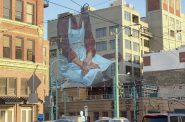 Apr 19th, 2020 by Tom Bamberger
Apr 19th, 2020 by Tom Bamberger
-
Scooters Are the Future
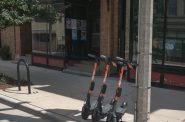 Dec 19th, 2019 by Tom Bamberger
Dec 19th, 2019 by Tom Bamberger
-
Homeless Tent City Is a Democracy
 Aug 2nd, 2019 by Tom Bamberger
Aug 2nd, 2019 by Tom Bamberger


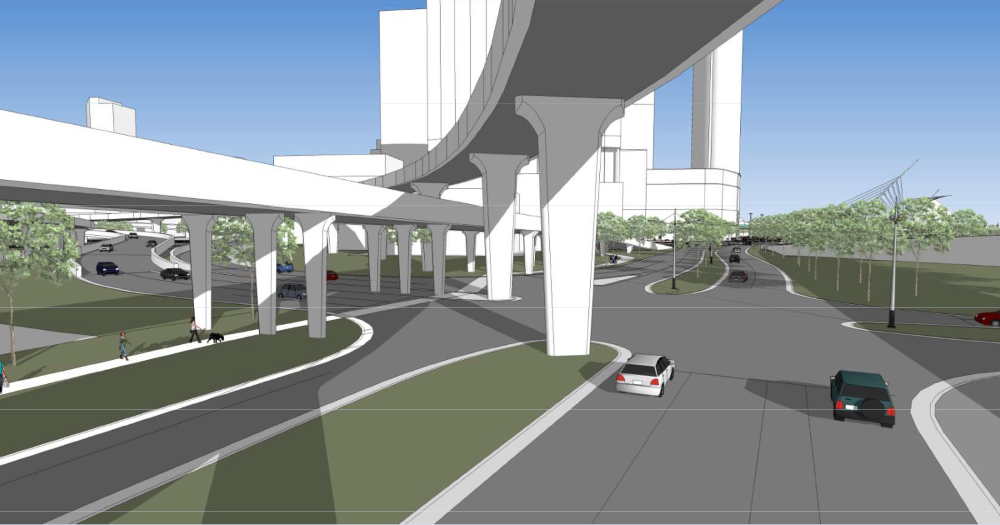



















Jeez, this article could sure do with some editing and fact checking, if not a major rewrite. It seems a shame that what might be a valid central premise could be overshadowed by such poor writing.
Yes, we have too much acreage given over to surface parking between the Third Ward and Downtown, but don’t forget that the Chicago & Northwestern terminal you laud brought with it the rail yards which previously occupied so much of this land.
Many people are citing Millenium Park in Chicago as a model for urban landscaping, but even that is wrapped and bisected by traffic lanes and parking lots, including several underground (as O’Donnell park has).
Lastly, your assumption that Lincoln Memorial serves only, or even primarily, suburban drivers seems like a reach. For any other than our most immediate northern suburbs — Shorewood and maybe Whitefish Bay — it’s hardly convenient. I-43 bears more of that traffic.
Although I certainly agree with Tom that removing more ramps, heck the Hoan (wrote about this in the past) and 794 completely, would have been much much more desirable, the concept that it is a bad project because of the Clybourn St intersection simply ignores the good of the project. It’s like saying we shouldn’t have torn down the Park East because of the massive intersection at Fond Du Lac and the Interstate (and the freeway that is McKinley). Just like Norquist compromised by building a massive McKinley and in fact by giving up on tearing down 794, Barrett compromised and got something: new development land, a more pedestrian friendly Michigan intersection (which is where people actually are), a new public plaza, and the opening up Clybourn, instead of nothing.
Just a couple other notes… I believe this project probably will cut into the number of parking spots as it runs roads through existing lots, and well we just might see the grid fixed up there as well. And a couple spots on the map that are currently parking are active or soon to be active redevelopment projects (833 for example).
That’s all for now.
I think it’s awful to think of building more parking garages, more parking lots and more highways. I believe that Milwaukee has enough of all of those. Particularly, the downtown area is cramped enough. I have worked 2nd shift downtown for nearly five years now. The parking situation is not that bad in my eyes. Unless there is an event like Summerfest, the Harley Anniversary, or something else that is BIG, there are plenty of places to park a car. The 411 Building between Wisconsin and Michigan aves always has room. The Pfister parking lot is expensive but there is a good chance to find a space. I’ve never used O’Donnell or any other garage downtown, because they’re simply too far from work. However there are many street parking spots available. You may have to walk a little further than expected, but that’s part of the deal. I guess the real trick is getting in at a good and early time. All things become difficult when you need to rush.
That being said I’d like to know how to fight against this plan. Who do I write to? Who do I call?
As if building more roadways, parking lots and parking garages is going to welcome more drivers and visitors to Milwaukee. There better be another plan in the works that complements the concrete plan, like new attractions or, say, some rebuilding of Milwaukee industries. Perhaps, like the author subtly hinted in the article, if some of these underused lots and garages were torn down, and the space used for parks and highly USABLE areas then I believe more people will become attracted to Milwaukee. This all comes down to, like the author again said, the love of the automobile. Despite the huge number of new drivers every year, a large portion of those who shouldn’t drive, and crumbling roads and bridges in this city, we still manage to get to work on time and get to our events and shows, don’t we?
Now I have taken the bus for the last year and it’s saved me tons of money. When I do drive a friends car or a family member’s car, I always find a parking spot. Beside the musical and cultural events that Milwaukee hold, usually revolving around the downtown area, I have managed to always find a parking spot. Im willing to run to work if I’m cutting it close. I am willing to work with what I’ve got. However, what will the experience be like if there are too many spaces, too many open garages, and too many ‘fairly priced’ lots? Seems to me a desolation.
now it seems to be something bigger than the automobiles and transportation services. This is about activity and business. They’re acting as though Milwaukee is busting at the seams with commerce and lifestyle so that the new additions of garages and so on are required to accommodate all our visitors and workers. Highly untrue. I’ve lived in Milwaukee for 25 years; I can attest to the spirit of laziness and unguidedness of our young people. I was once fresh out of college and feeling like a party animal. However, this feeling fades quickly and the real world comes knocking. I decided to work hard and build the things I want. Too many young people are out of work by choice, circumstance or what have you… with this kind of atmosphere it is highly implausible to create more grey space, because there aren’t enough people INSIDE milwaukee to fill those spaces. Who is going to drive downtown just to park if they have no business down there?
It’s a rant and I believe the article was stimulating enough to support that rant.
Great article and please let me know how to curb this road-plan.
When I head to events at the festival grounds or Discovery World (which I do on foot or bicycle) I must cross the intersection of Lincoln Memorial and Michigan St. That intersection is smaller with the removal of the turn lanes, and that will make it easier to cross on foot or bicycle. That alone makes the plan a winner for me.
The additional development site(s) is a plus that will net the city a couple million bucks every year (875 E. Wisconsin pays $1.7 million a year in property taxes). Plus a better connection (LMD) to the Third Ward will drive up the value of that land and make it more likely the Italian Community Center and others develop at least some of their hideous surface lots.
If you told me there was a situation where the city had no leverage against an highway-obsessed DOT, but was able to manage a bargain that yielded an improved Michigan/LMD intersection, more developable land, and a better connection between the Third Ward and East Town in exchange for a one-block-long, 10-lane road (mostly off-on ramps) I would take it every time. Rebuilding the status quo is a less productive move for the city.
It may seem paradoxical, but I believe this will reduce the amount of surface parking near the lakefront long-term.
The Hoan Bridge and 794 is a complete disaster. I’ve kind of given up caring. With that said, I believe linking up to the Third Ward will drive a lot of positive development. Also, better pedestrian access is positive. The fact that the DOT was willing to compromise at all is ecouraging.
Just a sad reminder that 794 and the Hoan should’ve been torn down. I still think the Buck’s new arena would’ve been an awesome fit along the lakefront, but it’s not possible with all the freeway wasted land.
To be honest, if the choice is between great views and a better flow of traffic, I’ll take a better flow of traffic. I’ll be far happier if I get to where I’m going smoothly and the view isn’t great than if the view is awesome but I’m stuck in traffic all day.
You bemoan that shift towards from cities being “destinations into vacuous drive-thrus for people going someplace else.” I like drive-thrus because they’re fast, and I’m OK with that shift.
Well Dan, why stop at 5 lanes? Why not 12? Hey, I have an idea. Let’s bring the old freeway plan back to life by connecting the two freeway spurs and build a skyway over the Lakefront. We wouldn’t want you stuck in that terrible Milwaukee traffic “all day”.
Saving two minutes on your drive is more important than great views. Wow. That is short-sighted and pretty silly.
Well, having cars stuck in traffic would add to their emissions, so even though you get that great view, it will all be underwater. Seems awfully short-sighted and silly to me.
A snorkel and flippers are cheaper than a car, and provide a great workout.
I don’t see any bike lanes and I think any forward thinking should include some kind of mass transit contraption. The exit ramps eastbound on 94 should be located a few blocks east to keep some semblance of green. We don’t need to dump all the traffic off at that particular spot.
Global Warming is a fact, with that said… how will we be under water?
The problem with the lake front downtown is cars. Too many cars everywhere and filling up most of the land with surface parking.
What does the new plan do according to DOT and City — increase the cars over 30% by 2036.
And now we are going to sell O’Donnell park to NML for parking?
If this is a good compromise, what would a bad one be?
This is a good deal like cancer is a good deal, the only alternative being run over by a truck.
^^ How is selling O’Donnell park to NML going to increase parking? It’s not like the city won’t be using the garage to, well, park cars. And if NML only allows employees to park there during weekdays, they will never fill the entire parking garage. Theoretically, the garage usage could decrease (this is admittedly unlikely due to low daytime public occupancy levels).
Also, I don’t think the DOT plan’s goal is to increase parking. The DOT simply predicts a traffic increase of 30% in that area in the future and wants to accommodate.
Let’s be honest, most of these parking lots/garages see their peak usage during Summerfest. It’s not like people are going to take more mass transit/live closer to Milwaukee for Summerfest alone. We might slowly replace the surface lots if they build more garages.
There are few people living all parts south that are in favor of tearing the Hoan Bridge down.
I agree with Dave, 794 should have been gone… the views with half of it gone are wonderful. But it’s not going to happen and Lincoln Memorial and 794 are our gateway whether we like it or not. While not a perfect plan, I do applaud the better focus on pedestrian and bicycle traffic at that gateway. I commute through there by car and/or cycle daily an I look forward to hopefully easier commuting through the area.
If congestion rebuilt city centers then LA would be the next New York.
Congestion is a product of a thriving urban center, not the cause of it. In our automotive centered culture (for which I’m so glad it is!) you need to balance improving access with fostering a vibrant community.
If we make downtown inaccessible to suburbanites, that will greatly reduce the likelihood of them coming down to work and play and thus add to the vibrancy of our city. On the flip side, if we build over and dice up all our neighborhoods with huge freeways through the heart of the city core it would destroy the urban fabric and the reasons to come downtown in the first place.
Love it or hate it, this plan is attempting to address that balance. That seems like an improvement in and of itself.
@a The plan will have an extension of the bike trail and possibly on-street lanes as well…
@Bamberger In fact this plan reduces surface parking. Not sure on the O’Donnell Garage yet but selling it to NML does offer the possibility of reducing parking instead of increasing parking downtown. How so? If they don’t buy it there is no doubt that NML will build a new garage (probably at Jackson and Wells were they just tore down a building), which would be a net increase in parking in downtown Milwaukee. And with the right deal NML could buy it but still have it open to the public (which they are indicating could be true) which would allow for a shared facility. Again another plus. That said this deal still requires a lot of scrutiny to insure it works for both NML and the public (financially and access).
@CJ Right.
I should also add that what Bamberger fails to point out is that it is the extension of Lincoln Memorial that creates the additional lanes. The rest is essentially a re-configuration of freeway ramps that already exist today.
The Hoan bridge is a symbol of Milwaukee and needs to remain. It does not block lakefront views unless you are in the industrial area just to the west of it. 794 is a necessity for the suburbs to have another access point to the city. There are + and – to the proposed Clybourn and Michigan intersections. At first glance looks like waste of space and confusing, but should improve congestion and be more visually attractive once you see the change. As with all of the recent changes to our freeway system, it simply takes some time to adjust. parking can be at capacity when larger events are ongoing, but is not usually full at other times and too expensive to be sure, at least in my point of view.
Bob, it’s not just about Lakefront views. The Hoan blocks development on some of the most valuable land in the State. It acts like a giant wall that kills the land under it and to a great extent on either side. Too late to tear it down, but it was shortsighted to build it in the first palce. It’s less a symbol of our city and more a symbol of our awful land use planning. And the only reason for 794 to exist is to finally connect the Hoan to something.
Bamberger fails to point out is that it is the extension of Lincoln Memorial that creates the additional lanes. The rest is essentially a re-configuration of freeway ramps that already exist today.
I have no quarrel with this, in fact your point is illustrated in my article.
My point is putting all of these lanes together in one intersection is a problem. That is, moving all this stuff together intensifies the automobile infrastructure.
Also, note that projections are really self-fulfilling prophecies. When you build it, they will come.
I can’t imagine you could find any urbanist in the country who would see what we are doing as anything other than a tragic missed opportunity.
Finally, Dave how many parking spaces are going to eliminated? 15 or 20? That along with the one new lot to build are just crumbs. This doesn’t sound like a compromise. Meanwhile, instead of taking up the good fight against sprawl etc the plan insures our lake front will continue to be a high volume traffic corridor for suburban commuters for the next three decades at least.
@Bamberger Some Park guy(I’m fairly certain he’s an urbanist) says this about the project: “That’s a good start, but removing all of I-794 would be much better.” Agreed most urbanists (myself included) would prefer the Hoan and 794 gone completely, but even Norquist recognized (yup Norquist gave up on removing 794) this wasn’t a winnable battle, so the city got something (what Park said), instead of nothing.
The problem with WISDOT solutions when they come into contact with a really complex area like this is that they have a tunnel vision that only centers on the movement of cars. Everything else will either get left out or added as an afterthought which is why there is no highway in Wisconsin that has ever included facilities for mass transit not to mention bikes or people. It is a failing of the Facilties Development Manual (FDM). Some of the early alternatives for the interstate highways in Milwaukee like the 1971 Barton-Aschman, Milwaukee Area Transit Plan, included rapid transit corridors designed as part of the highway system and also dedicated bus lanes and stations. These beautiful plans were never implemented and with the redesign of the Zoo Interchange and the Stadium Interchange, where they would deserve consideration, dedicated mass transit lanes were completely absent from any alternatives, which boggles the mind.
The design alternatives presented in the PIM’s are specifically implemented, as Tom says, to increase traffic at the expense of pedestrian and bicycle access and offering a larger expanse of “lovely” concrete in an area that should be greener instead of grayer. I was taken aback talking with some of the consultants at the initial PIM who were trying to justify building a more robust interchange when they didn’t have the traffic projections to back up the proposed expansions.
Unfortunately the lack of a solid Master Plan for this entire area which should have been a joint effort by the City and County, crap like this will get pushed through by WISDOT. When the Calatrava was built almost fifteen years ago, they should have hired a world-class urban planner to make a comprehensive Master Plan setting the groundwork for a perfect solution to this mess. Is it too late? Probably not, but the local politicians shouldn’t waste time putting together an RFP for a comprehensive Master Plan. If not, the constraints put in place by this design will kill anything impressive for the rest of our lifetimes.
Fortunately, whatever concrete is laid down on Lincoln Memorial Drive will one day be considered for streetcar tracks. This utility would bring large numbers of people (sans cars) to the Lakefront, and their presence will dominate land use. The current streetcar plan includes several blocks of St. Paul, but turns north before the lakefront area. A simple extension to the East and a run up Lincoln Memorial Drive to the campus will link two dense areas, which is the formula for successful public transportation.
The divided highway into the Third Ward is flawed by omission, raising the question – what do we do with all that traffic arriving at Chicago Street? If it is development that we wish for with these new roads, then we need people who will arrive with the idea that walking will be popular and fun.
Finally, Tom’s mapping of parking lots does not including the many mini-lots scattered around downtown and third ward buildings. Another expert on downtown parking reports a calculation of 46% of land devoted to parked cars.
Nice article. Yep, it’s basically a highway right on the lakefront. Those giant intersections will certainly kill pedestrian activity.
That winding ramp looks nice, but it also looks very inconvenient and time-consuming for walkers.
I’m not a fan of this plan.
Dave
“this wasn’t a winnable battle, so the city got something (what Park said), instead of nothing.”
How do you know a battle is not winnable without going to battle?
Concrete (or asphalt) near the water is a very bad idea; our penchant to park next to “anywhere” is creating a significant threat to the lake. Rain will wash the streets “clean” but the run off goes quickly into the lake. The pollutants that runoff carry are a broad spectrum of automobile emitted poisons, oil, rubber as well as sea gull poop which has the highest ecoli counts compared to other animals; and the gulls are abundant. Recent research from the School of Freshwater Sciences: http://dc.uwm.edu/cgi/viewcontent.cgi?article=1298&context=etd start at page 10.
I would add to your insifht about the destruction of life in the city center that the “development” that the suburbs are getting is not anything that we in the suburbs need, want or benefit from. You state that the city center becomes ‘like’ a shopping mall parking lot. It does. The suburb BECOMES a shopping mall parking lot. We in the suburbs also get the shopping mall with its minimum wage jobs, fast food (obesity epidemic) and conveyer belt of cheap products made in slave labor conditions in poor countries.
I liked the idea of this project much better before seeing the renderings. There is no urban feel to them whatsoever. Hopefully the finished product will not look so sterile.
The article and comments here are excellent. Mr. Bamberger’s and many readers’ criticism is spot on.
However, I think the deal is more than a superficial success. It is a step in the right direction. It slightly improves the ability of 794 to bring people downtown and frees a little land from suburbia. I’m hopeful that WisDOT’s projected increases are due to more people coming downtown rather than driving through and more people coming downtown will in time lead to more people living downtown.
My bigger issue (my pet issue) is that 794 will stupidly continue to act as a giant on-ramp to the interstate system for St. Francis and Cudahy taking up valuable land in the central business district. Nevertheless, I think that ship sailed when the final design for the Marquette was selected. Hopefully, when the 50 year rebuild comes due the politics allow for a better design.
Castle Rock Lake is Wisconsin’s 4th largest lake.
It is located just 3 hours from Chicago and Minneapolis, 2 hours from Milwaukee, 1 hour from Madison,
and 20-25 minutes from the Wisconsin Dells.
http://www.castlerocklake.com/
@Tom B And as I predicted NM is now moving to build a 1,000 car garage (with some mixed-use element which could make it better, but we’ll see) in East Town. Yup, not selling the existing garage is increasing parking in East Town. http://urbanmilwaukee.com/pressrelease/northwestern-mutual-moves-forward-on-downtown-milwaukee-growth/
What?? This article is just terrible… It sounds like a little girl crying because her parents want to take her from a swimming pool to Universal Studios… Nevermind the Couture tower, NML tower, new Bucks arena, Carroll Properties of Chicago’s tower and real estate developments, Marcus Theater’s downtown project, the art museum, veterans memorial, and streetcar projects huh?? Umm, the area is becoming urbanized.. More accessable ways in and out are needed…. Please stop uttering mere nothings at the gateway plaza’s development…. This article is a broken toenail to the foot… Go wine elsewhere please….
Yes, NML plans to build their own garage but that’s to meet the needs of up to 1,800 more employees they plan to hire for their new HQ. NML currently has about 150 employees parking at O’Donnell Park of the 700 monthly parkers there (and a waiting list).
So where were all those current O’Donnell parkers going to park if they got displaced by NML employee parkers? Would they magically start carpooling or taking the bus?
If we want fewer parking garages/lots downtown we need either fewer people driving into the city (better regional mass transit) or to stop developing new buildings (not a good option).
But making the sweetheart sale of public park about a corporation’s need for a parking garage was a good ploy. Few people care about parking garages, many fewer than care about parks.